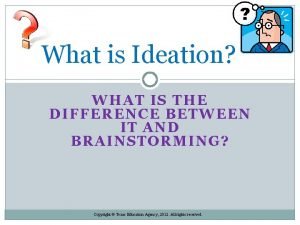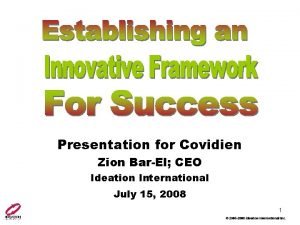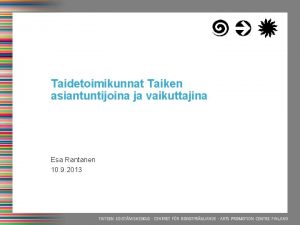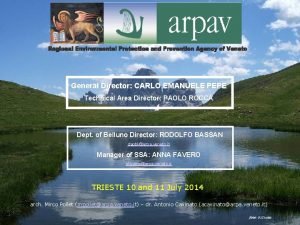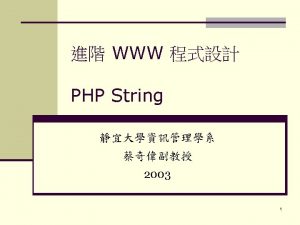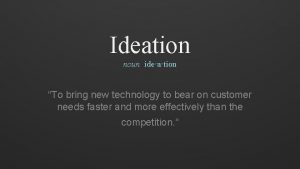Ideation and Design Thinking Echo Rantanen Technical Manager















- Slides: 15

Ideation and Design Thinking Echo Rantanen Technical Manager, USA & Canada

© 2015 Cisco and/or its affiliates. All rights reserved. Cisco Public 2

• Gain an understanding of methodology • Look at some of the Hackathon Day 1 concepts • Note next week – Hackathon Facilitation Training, November 9 and 10 © 2015 Cisco and/or its affiliates. All rights reserved. Cisco Public 3

• Student think they will prototype for 3 full days! • Students are going to want to jump to the prototyping phase • Our team had a similar struggle – we wanted to play with the kits Technical Manager Hackathon San Jose © 2015 Cisco and/or its affiliates. All rights reserved. Cisco Public 4

• Ideation does not necessarily start with an idea • An idea is the output of the innovation process, not the starting point • The goal should be to construct the single, best solution to satisfy the unmet needs • You ideate in order to transition from identifying problems into exploring solutions for your users © 2015 Cisco and/or its affiliates. All rights reserved. Cisco Public 5

• Step beyond obvious solutions and thus increase the innovation potential of your solution set • Harness the collective perspectives and strengths of your teams • Uncover unexpected areas of exploration • Create fluency (volume) and flexibility (variety) in your innovation options • Get obvious solutions out of your heads, and drive your team beyond them Regardless of what ideation method you use • The fundamental principle of ideation is to be cognizant of when you and your team are generating ideas and when you are evaluating ideas – typically keeping these two tasks separate, and only mixing the two intentionally © 2015 Cisco and/or its affiliates. All rights reserved. Cisco Public 6

• Institute of Design at Stanford - http: //dschool. stanford. edu/ • Virtual Crash Course Video - http: //dschool. stanford. edu/dgift/#gear-up • 80 minute video with a one hour activity to redefine the gift-giving experience • Walks through the five stages of Design Thinking © 2015 Cisco and/or its affiliates. All rights reserved. Cisco Public 7

• Empathize – talking to customers directly • Define - defining a problem statement from the empathy work • Ideate – brainstorming ideas to solve a problem • Prototyping – build and make things • Test – test with users © 2015 Cisco and/or its affiliates. All rights reserved. Cisco Public 8

© 2015 Cisco and/or its affiliates. All rights reserved. Cisco Public 9

© 2015 Cisco and/or its affiliates. All rights reserved. Cisco Public 10

© 2015 Cisco and/or its affiliates. All rights reserved. Cisco Public 11

© 2015 Cisco and/or its affiliates. All rights reserved. Cisco Public 12

Thank you.

• So many times we start with a problems designed for us • Design is messy • Take a first pass at the problem statement • Short, specific and sexy = good problem statement • Explore the possibilities in the solution space • New solution – Iterate • Build Prototype – Build your solution • Test - Share your solution and get feedback • Usually when given a challenge we accept that challenge put our heads down and think our way through a problem and hopefully show a right answer at the end © 2015 Cisco and/or its affiliates. All rights reserved. Cisco Public 14

• Be human-centered in the way you work • Have empathy – spend time with the people whose lives are impacted by the things you do – reveal insight into what their latent needs are • Attitude of prototyping in everything you do – test what’s working and what is not • Be more collaborative – divert team – innovation is a team sport • Have a bias toward Action – get up and do something • Make your instincts change © 2015 Cisco and/or its affiliates. All rights reserved. Cisco Public 15
![[-n $home] 2 echo $? 3 [-z shome] 4 echo $? [-n $home] 2 echo $? 3 [-z shome] 4 echo $?](data:image/svg+xml,%3Csvg%20xmlns=%22http://www.w3.org/2000/svg%22%20viewBox=%220%200%20200%20200%22%3E%3C/svg%3E) [-n $home] 2 echo $? 3 [-z shome] 4 echo $?
[-n $home] 2 echo $? 3 [-z shome] 4 echo $? New buzz word for brainstorming
New buzz word for brainstorming Brilhart-jochem ideation criteria
Brilhart-jochem ideation criteria Ideation triz
Ideation triz Nursing care plan for homicidal ideation
Nursing care plan for homicidal ideation Santtu rantanen
Santtu rantanen Malla rantanen
Malla rantanen Music festivals in finland
Music festivals in finland Tss met 40
Tss met 40 Esa rantanen taike
Esa rantanen taike Piki rantanen
Piki rantanen Piki rantanen
Piki rantanen Mika rantanen
Mika rantanen Echoboomer
Echoboomer General pepe
General pepe Senior manager vs general manager
Senior manager vs general manager
![[-n $home] 2 echo $? 3 [-z shome] 4 echo $? [-n $home] 2 echo $? 3 [-z shome] 4 echo $?](https://slidetodoc.com/wp-content/uploads/2021/03/4520173_09339f8d6296694d67adb66823cc7f1f-300x225.jpg)
